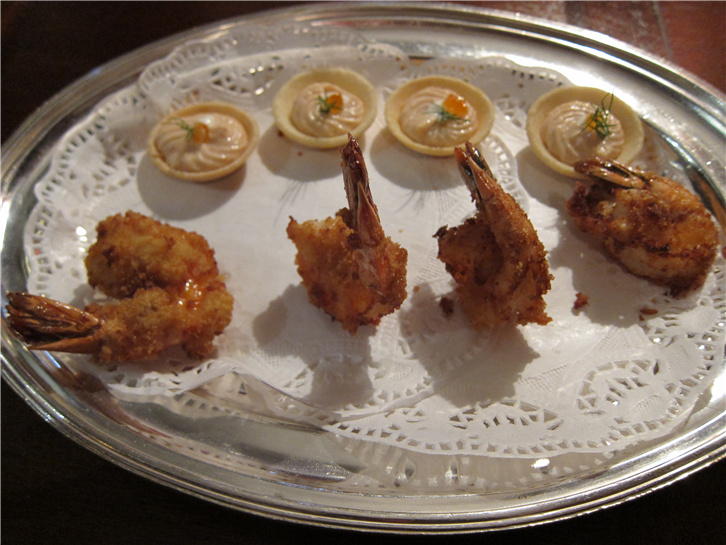From Ongar to Le Gavroche
Saturday, January 10th , 2009

Regular readers will know that I have a certain aversion to travel outside the tube network, but occasionally I need to visit Essex, a county with a grand total of just 10 restaurants in the 2009 Good Food Guide (the highest rated 3/10). That is one Good Food Guide entry per 130,000 people; by comparison Devon manages 23, with about one per 46,000 people, and Cumbria has 21 entries at one per 23,000. In 2008 I was delighted to be introduced
The Headley, but most of my food experiences in this county have been gruesome. I was therefore pleasantly surprised to try
Smith’s in Ongar (hat tip to AC for the suggestion), despite its reputation as a hangout for footballer’s wives, who are seemingly rarely noted for their discerning foodie instincts. The positive thing about Smith’s was that the seafood was of good quality: we tried a wild bass and tasty Dover sole. The wine list is fairly priced and the waitresses were well trained. There were inconsistencies, but the one major cooking error was fixed politely and without fuss. Value for money is debatable, but seafood does cost a lot of money, and the portion of wild sea bass I was served would have fed two in a London restaurant.
Bocca di Lupo has had some remarkably positive reviews, and perhaps my expectations were too high. What I found was some very pleasant Italian cooking, with a quirky menu that was less appealing than many, but generally good execution of dishes. The wine list is fairly priced and the prices were not excessive for the level of cooking on display. However, quite why you would choose this over somewhere like
La Trenta is less than obvious to me.
The
Princess Victoria is a highly successful makeover of a Shepherds Bush pub, with an ex Greenhouse chef and an ex Capital manager. This is everything a gastropub should be but so rarely is, the ingredients carefully chosen, the menu appealing, the cooking technique solid. This has the bonus of a very fine wine list, and the place is doing great business even in these difficult times.
If you eat in the evening at
Le Gavroche you will shell out a lot of money, but of you are able to go for lunch then you will find a real bargain. £48 all in (including wine) lets you try some serious cooking. This week I sampled a tasty prawn nibbles (pcitured), deeply flavoured lobster bisque, brilliant chicken mousse with Roquefort and apples, a lovely rich game pie and sauce and a delicate pear dessert. These dishes demonstrated top-notch technique and put to shame many of the “cheap lunch” menus in London, which often feature very cheap ingredients and limited effort. Here the ingredients may not be the height of luxury at lunch, but the classy technique shines through.
The limitation of web-based voting food guides was put into focus this week when I glanced at the new 2009 Zagat “Europe’s Top restaurants”. All manner of absurdities pop out, but it is particularly laughable when you try and compare scores across cities. Chez Bruce, very nice one star Michelin restaurant that it is, weighs in with a hefty 29/30, a higher score than any restaurant in Paris. I seriously doubt that Bruce Poole himself (a very nice man indeed) would share this opinion, even after a few beers. Spondi in Athens, which is by all accounts a very good restaurant, recently promoted to two stars, also basks in a 29/30 glow, higher than any restaurant in, for example, Brussels or Rome. I’ll stop there as looking at this nonsense further will just be depressing. This particular Zagat guide is an excellent demonstration that the “wisdom of crowds” may be fine for estimating the weight of a butchered ox, but not for figuring out where to eat it.
One effect of the economic turmoil on restaurants which has not been written about much is the effect of the decline of the pound relative to the euro. Now that the UK has slashed interest rates and the government moved from a level of national debt that was vaguely respectable in 2007 to what is technically known as “crazed addicted gambler” level, the currency markets have responded logically by dumping the pound. This stands today at 1.1 Euros to the pound compared to just under EUR 1.50 between 2002 and 2007. London restaurants buy a lot of produce from Europe, so this hurts. I was speaking to a restaurateur this week that in November 2008 was paying £10.50 for a box of spinach; this has now risen to £18. Since restaurants hardly dare increase their prices in the current economic climate, this is eating into margins. This may appear to be good for us, the consumer, but at some point restaurants will want to pass these cost increases back, and in the long term if they cannot then more places will go to the wall. While some places that opened in the boom times will not be missed, hard times affect good restaurants as well as bad, and I have recently noticed good local restaurants like The Brackenbury going to meet their maker. Local sourcing where possible is certainly making economic sense at the moment.
I dislike eating out in December, with its inflated prices and restricted festive menus, but January and February is the time that us foodies have their revenge, with restaurants desperate to fill tables. One bargain at this time of year (10
th January to 13th February) is the FT-sponsored: “Take a Friend for a Fiver”. Over 150 restaurants are participating, including Umu, Scott’s, The Vineyard at Stockcross, and even the Ivy. Details are to be found on this site:
www.ft.com/lunch. Be aware that you need to collect three vouchers from the FT.
My radio interview on US National Public Radio can be heard
here.
